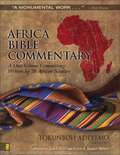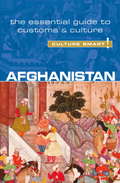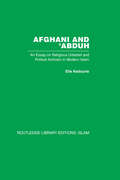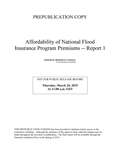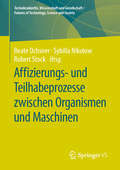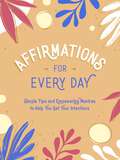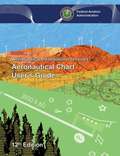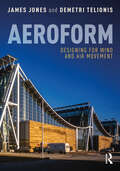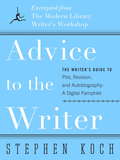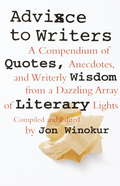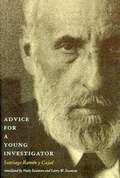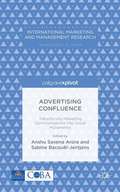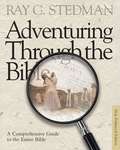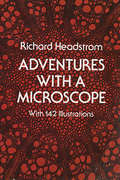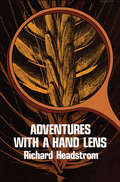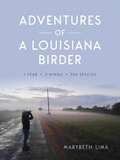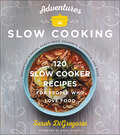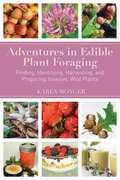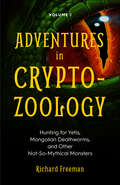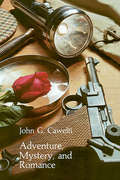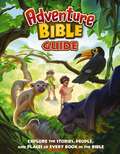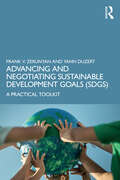- Table View
- List View
Africa Bible Commentary: A One-Volume Commentary Written by 70 African Scholars
by ZondervanThe Africa Bible Commentary is a unique publishing event—the first one-volume Bible commentary produced in Africa by African theologians to meet the needs of African pastors, students, and lay leaders. Interpreting and applying the Bible in the light of African culture and realities, it furnishes powerful and relevant insights into the biblical text that transcend Africa in their significance. The Africa Bible Commentary gives a section-by-section interpretation that provides a contextual, readable, affordable, and immensely useful guide to the entire Bible. Readers around the world will benefit from and appreciate the commentary’s fresh insights and direct style that engage both heart and mind. Key features: · Produced by African biblical scholars, in Africa, for Africa—and for the world · Section-by-section interpretive commentary and application · More than 70 special articles dealing with topics of key importance in to ministry in Africa today, but that have global implications · 70 African contributors from both English- and French-speaking countries · Transcends the African context with insights into the biblical text and the Christian faith for readers worldwide
Afghanistan - Culture Smart!
by Moska Najib Nazes AfrozAfghanistan is situated at the crossroads of Asia, a strategically important location that connects the Middle East with Central Asia and the Indian subcontinent. Down the ages it has been subjected to continuous foreign invasion and intervention--from Alexander the Great to Genghis Khan, and as a pawn in the struggle between the British and Russian Empires--making its people wary of outsiders. That history is being repeated in the twenty-first century. Afghanistan has always been seen from the outside as a realm of much intrigue and many myths. The Afghans tried to keep their distance from the outside world--especially from the Europeans who, whether in pursuit of imperial goals or simply as explorer-travelers, attempted to enter and traverse the land. Their very elusiveness attracted Westerners to this landlocked country of high mountains and breathtaking beauty, where age-old customs and traditions were zealously guarded, sometimes at the cost of many lives. The Afghan people are a tapestry of ethnicities woven over time--Pashtuns, Tajiks, Hazaras, Uzbeks, and many smaller ones. Society is organized mainly along ethnic and tribal lines, but ethnic identity becomes irrelevant when a common enemy threatens to take control of the country. There are also many shared values and unwritten codes of conduct that govern interpersonal relations, which are not taken lightly. Visitors are struck by the simplicity, hospitability, dignity, and generosity of the Afghan people, and often confounded by customs that they find hard to understand. Culture Smart! Afghanistan is a unique introduction to the background, habits, traditions, idiosyncrasies, suspicions about foreigners, and patterns of behavior of the Afghan people. It offers visitors invaluable information and insights that will help them to interact with Afghans, to interpret their behavior, and to behave appropriately in their company, whether in personal or business exchanges. Once the ice is broken, the rewards will be great.
Afghani and 'Abduh: An Essay on Religious Unbelief and Political Activism in Modern Islam
by Elie KedourieFirst published in 2008. Routledge is an imprint of Taylor & Francis, an informa company.
Affordability of National Flood Insurance Program Premiums: Report 1
by Committee on the Affordability of National Flood Insurance Program PremiumsThe National Flood Insurance Program (NFIP) is housed within the Federal Emergency Management Agency (FEMA) and offers insurance policies that are marketed and sold through private insurers, but with the risks borne by the U. S. federal government. NFIP's primary goals are to ensure affordable insurance premiums, secure widespread community participation in the program, and earn premium and fee income that covers claims paid and program expenses over time. In July 2012, the U. S. Congress passed the Biggert-Waters Flood Insurance Reform and Modernization Act (Biggert-Waters 2012), designed to move toward an insurance program with NFIP risk-based premiums that better reflected expected losses from floods at insured properties. This eliminated policies priced at what the NFIP called "pre-FIRM subsidized" and "grandfathered. " As Biggert-Waters 2012 went into effect, constituents from multiple communities expressed concerns about the elimination of lower rate classes, arguing that it created a financial burden on policy holders. In response to these concerns Congress passed The Homeowner Flood Insurance Affordability Act of 2014 (HFIAA 2014). The 2014 legislation changed the process by which pre-FIRM subsidized premiums for primary residences would be removed and reinstated grandfathering. As part of that legislation, FEMA must report back to Congress with a draft affordability framework. "Affordability of National Flood Insurance Program Premiums: Report 1" is the first part of a two-part study to provide input as FEMA prepares their draft affordability framework. This report discusses the underlying definitions and methods for an affordability framework and the affordability concept and applications. "Affordability of National Flood Insurance Program Premiums" gives an overview of the demand for insurance and the history of the NFIP premium setting. The report then describes alternatives for determining when the premium increases resulting from Biggert-Waters 2012 would make flood insurance unaffordable.
Affizierungs- und Teilhabeprozesse zwischen Organismen und Maschinen (Technikzukünfte, Wissenschaft und Gesellschaft / Futures of Technology, Science and Society)
by Robert Stock Beate Ochsner Sybilla NikolowDer Band reflektiert Forschungspraktiken, die für das Projekt der Biokybernetik wie der aktuellen bionischen Prothetik und Medienökologie charakteristisch sind: die Suche nach einem dritten Weg zwischen Technologisierung des Bios und Biologisierung von Technik. Durch ihre möglichst dichten Beschreibungen der jeweiligen wechselseitigen Affizierungs- und Teilhabeprozesse zwischen Mensch und Technik tragen die wissenschaftshistorischen, philosophischen, kultur- und medienwissenschaftlichen Beiträge dazu bei, den Blick auf die bewusste Annäherung der Zwei Kulturen durch die gegenwärtigen Lebens- und Kulturwissenschaften zu erweitern. Dies wird u.a. durch die Kontextualisierung der Debatten in Bezug auf das Verhältnis zwischen Maschinen und Organismen sowie Artifiziellem und Natürlichem geleistet.
Affirmations for Every Day: Simple Tips and Empowering Mantras to Help You Set Your Intentions
by Summersdale PublishersThis beautiful book is filled with simple tips and affirmations to help you feel calm and confident every dayAn affirmation or mantra is a short phrase that focuses your attention. Whether you want to inspire confidence, a sense of calm or a positive mindset within yourself, they are a powerful way to declare your intentions and set yourself on track.As well as a beautiful selection of words from writers and thinkers, and 40 inspiring mantras, within these pages you will find a raft of simple but effective tips to help you master the art of affirmations, including:How to write an effective affirmationUsing affirmations to achieve your goalsWays to cultivate an open and positive mindsetJust a few words said with purpose can give you inner strength that will last all day. Tap into this power with the guidance in this book, and allow these words to inspire you on your life’s journey.
Affirmations for Every Day: Simple Tips and Empowering Mantras to Help You Set Your Intentions
by Summersdale PublishersThis beautiful book is filled with simple tips and affirmations to help you feel calm and confident every dayAn affirmation or mantra is a short phrase that focuses your attention. Whether you want to inspire confidence, a sense of calm or a positive mindset within yourself, they are a powerful way to declare your intentions and set yourself on track.As well as a beautiful selection of words from writers and thinkers, and 40 inspiring mantras, within these pages you will find a raft of simple but effective tips to help you master the art of affirmations, including:How to write an effective affirmationUsing affirmations to achieve your goalsWays to cultivate an open and positive mindsetJust a few words said with purpose can give you inner strength that will last all day. Tap into this power with the guidance in this book, and allow these words to inspire you on your life’s journey.
Aeronautical Chart User's Guide: Aeronav Products (FAA Handbooks Ser.)
by Federal Aviation AdministrationThe updated 11th edition of the Aeronautical Chart User’s Guide by the FAA is a great reference for novice pilots and professionals alike. Printed in full color with detailed examples, this book provides all the information students and pilots need to know about all the symbols and information provided on US aeronautical charts and chart navigation publications. Readers will find information on VFR charts, aeronautical chart symbols, helicopter route charts, flyway planning charts, IFR enroute charts, explanation of IFR enroute terms and symbols, Terminal Procedure Publications (TPPs), explanation of TPP terms and symbols, airspace classifications, and an airspace class table.
Aeroform: Designing for Wind and Air Movement
by James Jones Demetri TelionisAeroform: Designing for Wind and Air Movement provides a comprehensive introduction to applying aerodynamic principles to architectural design. It presents a challenge to architects and architectural engineers to give shape to the wind and express its influence on architectural form. The wind pushes and pulls on our buildings, infiltrates and exfiltrates through cracks and openings, and lifts roofs during storm events. It can also offer opportunities for resource conservation through natural ventilation or a biophilic connection between indoors and out. This book provides basic concepts in fluid mechanics such as materials, forces, equilibrium, pressure, and hydrostatics; introduces the reader to the concept of airflow; and provides strategies for designing for wind resistance, especially in preventing uplift. Natural ventilation and forced airflow are explored using examples such as Thomas Herzog’s Hall 26 in Hanover, RWE Ag building in Essen Germany, and the Kimbell Art Museum in Texas. Finally, issues of wind and airflow measurement are addressed. A reference for students and practitioners of architecture and architectural engineering, this book is richly illustrated and presents complex concepts of aerodynamic engineering in easy-to-understand language. It prepares the architect or architectural engineer to design buildings that are visually expressive of a dialogue between wind and built form.
Advisory Circular AC 43.13-1B With Change 1 AC 43.13-2B
by U.S. Department of Transportation Federal Aviation AdministrationThe "bible" for AMTs, aircraft owners, and homebuilders, this FAA Advisory Circular outlines the standards for acceptable methods, techniques, and practices for the inspection, repair and alteration of non-pressurized areas of civil aircraft with a gross weight of 12,500 lbs or less. Includes both Part 1B and Part 2B. This edition contains: AC 43.13-1B Acceptable Methods, Techniques, and Practices: Aircraft Inspection and Repair, with Change 1 (effective September 2001) AC 43.13-2B Acceptable Methods, Techniques, and Practices: Aircraft Alterations (effective March 2008). Note that AC 43.13-2B can now be used as approved data.
Advice to the Writer
by Stephen KochFrom Stephen Koch, former chair of Columbia University's graduate creative writing program, comes essential and practical advice drawn from The Modern Library Writer's Workshop. With nearly thirty years of teaching experience, Stephen Koch has earned a reputation as an astute and benevolent mentor; and with Advice to the Writer, his lucid observations and commonsense techniques have never been more accessible. Here Koch dispenses sound guidance for those moments when the muse needs a little help finding her way: in "Shaping the Story," he untangles plot; in "Working and Reworking," he explains the most teachable (yet least often taught) of all writerly skills: revision; and in "The Story of the Self," he delves into autobiography. Featuring handpicked commentary from some of our greatest authors, Advice to the Writer is a unique introduction to this maddening and intoxicating pursuit. Praise for Stephen Koch's The Modern Library Writer's Workshop "An extraordinarily comprehensive and practical work by a master craftsman and a master analyst of the craft."--Madison Smartt Bell, author of All Souls' Rising and Anything Goes "Stephen Koch was my teacher long ago. Now he is everyone's teacher, indelibly. This is a book not just for the beginning writer but for every writer."--Martha McPhee, author of the National Book Award nominee Gorgeous Lies "The Modern Library Writer's Workshop is a treasure trove of wisdom, both immensely practical and philosophical, entertaining and thought-provoking. Koch takes us inside the writing process, and it is impossible not to emerge transformed."--Joanna Hershon, author of Swimming
Advice to Writers: A Compendium of Quotes, Anecdotes, and Writerly Wisdom from a Dazzling Array of Literary Lights
by Jon WinokurJon Winokur, author of the bestselling The Portable Curmudgeon, gathers the counsel of more than four hundred celebrated authors in a treasury on the world of writing. Here are literary lions on everything from the passive voice to promotion and publicity: James Baldwin on the practiced illusion of effortless prose, Isaac Asimov on the despotic tendencies of editors, John Cheever on the perils of drink, Ivan Turgenev on matrimony and the Muse. Here, too, are the secrets behind the sleight-of-hand practiced by artists from Aristotle to Rita Mae Brown. Sagacious, inspiring, and entertaining, Advice to Writers is an essential volume for the writer in every reader.
Advice for a Young Investigator
by Neely Swanson Larry W. Swanson Santiago Ramón y CajalSantiago Ramón y Cajal was a mythic figure in science. Hailed as the father of modern anatomy and neurobiology, he was largely responsible for the modern conception of the brain. His groundbreaking works were New Ideas on the Structure of the Nervous System and Histology of the Nervous System in Man and Vertebrates. In addition to leaving a legacy of unparalleled scientific research, Cajal sought to educate the novice scientist about how science was done and how he thought it should be done. This recently rediscovered classic, first published in 1897, is an anecdotal guide for the perplexed new investigator as well as a refreshing resource for the old pro. Cajal was a pragmatist, aware of the pitfalls of being too idealistic -- and he had a sense of humor, particularly evident in his diagnoses of various stereotypes of eccentric scientists. The book covers everything from valuable personality traits for an investigator to social factors conducive to scientific work.
Advertising Confluence: Transitioning Marketing Communications into Social Movements
by Anshu Saxena Arora Sabine Bacouël-JentjensAdvertising Confluence offers a unique blend of both traditional and contemporary social media thinking about advertising and integrated brand promotions from both the developed and emerging world.
Adventuring Through The Bible: A Comprehensive Guide to the Entire Bible
by Ray C. StedmanUnderstanding the Bible can be somewhat intimidating for laypersons. However, the new and improved edition of Adventuring Through the Bible is designed to give readers a thorough overview of the entire Bible in an easy and exciting way. Features more than 1,000 pages filled with outlines, themes, and applications to help the reader grasp the message of each book of the Bible. Provides the reader with a one-stop guide for studying and understanding God's Word.
Adventures with a Microscope
by Richard HeadstromWith a simple microscope and this book, you can embark on 59 wonderful adventures in the natural world -- make discoveries about the structures of numerous microscopic animals; find out what everyday objects and foods really look like at the cellular level; gain an understanding of how to prepare specimens and slides; and learn about many scientific phenomena such as how a fly can walk upside down on the ceiling. It's all here in simple-to-understand language and 142 clear line drawings.The author first examines under the microscope such everyday objects as a human hair, air bubble, scale of a herring, poppy seed and sugar crystal, and then offers through-the-microscope views of such creatures and objects as the water flea, hydra, house fly, amoeba, euglena, volvox, diatoms, desmids, algae, blood corpuscles, honey bee, rotifer, water-mites, potato starch, and other food substances, lichen, paramecium, coffee, sponge, chalk, yeast, bacteria, mustard, pepper, bryozoan, moss, mushroom, molds, cotton, and other textile fibers, ferns, dragon-flies, flea, spider, roots, and other plant structures, paper, aphid, fingerprints, nervous system of the grasshopper, and more.Richard Headstrom, formerly associated with the New England Museum of Natural History and an experienced teacher and writer on natural science for young people, has made this book simple enough for any beginner at home as well as interesting for more experienced students and lay readers. Enjoyable and instructive, these adventures with a microscope will appeal to all who are curious about what there is to see beyond the range of the naked eye.
Adventures with a Hand Lens
by Richard HeadstromWith an ordinary magnifying glass and this book as your guide, 50 adventures in close observation await you. These entertaining nature studies take you on field trips in and around your home, calling attention to interesting features of dozens of familiar or overlooked plants, insects, and other animals, and common materials like cloth, quartz, and the paper on which this book is printed.A great deal of basic natural-science theory and detail is presented in this delightful narrative. Flowers and grasses, fish scales, moth and insect wings, egg cases, buds, feathers, seeds, leaf scars, moss, molds, ferns, and common crystals are among the many structures examined, often comparatively. Many natural processes and behavior patterns are observed -- seed dispersal and other methods of reproduction, protective coloration, rusting symbiosis, fertilization of the soil, breathing and case building of insects, and many others, all with only an inexpensive hand lens as equipment and with "specimens" you probably pass by going for a walk. More than 200 labeled illustrations accompany the text.The author is a former teacher and associate curator of the New England Museum of Natural History. No previous science background is assumed of readers, and curious readers of almost any age will find this book an interesting introduction to numerous facets of nature study.
Adventures with Leaders & Enders: Make More Quilts in Less Time!
by Bonnie K. HunterAn easy method to faster quilt-making, and incredible patterns to make use of your scrap stash. What if you could piece quilts even faster, work on more than one quilt simultaneously and save money, fabric and thread all at the same time? Bonnie K. Hunter will show you how to put the concept of Leaders & Enders to work quickly and easily, expanding your creativity, and upping your productivity all at the same time. If you have ever found yourself paralyzed by your stash, overwhelmed by scraps you just can't bear to toss out, arm yourself with a new rotary blade for your cutter, make yourself a cup of tea and start reading. This book is not only full of beautiful scrap quilts that can be made in between the lines of other sewing, but also contains many ideas for getting your ever burgeoning scrap stash under control, into useable sized pieces that work well with one another, and ready to be sewn into quilts you've always wanted to make. Bonnie K. Hunter has done it again!
Adventures of a Louisiana Birder: One Year, Two Wings, Three Hundred Species
by Marybeth LimaThis candid and humorous chronicle shows how one woman goes from casual observer to obsessive bird nerd as she traverses Louisiana’s avian paradise. In Adventures of a Louisiana Birder, readers follow Marybeth Lima across her adopted state in search of 300 species of birds. Bisected by the Mississippi flyway and home to 400 miles of coast, Louisiana has a variety of habitats, which serve as a beautiful backdrop to this remarkable journey. In birding circles, some devotees attempt what is known as a “big year,” a bird-sighting challenge to identify as many bird species as possible in a particular geographical area over the course of one year. Lima’s initial effort amounted to 11,626 miles in sixty-one road trips to log an impressive 280 species. But on a subsequent quest to exceed her record, she endures elusive birds, embarrassing misidentifications, and hungry insects in an effort to reach her goal. In the midst of these obstacles, Lima celebrates the camaraderie and friendly competition among fellow birders, from novices to a world-renown ornithologist. Requiring both mental focus and physical agility, birdwatching becomes an active sport through Lima’s narration. She vividly conveys the elation over a rare species seen or heard and the disappointment when one is narrowly missed. An appendix provides the location and date of every species she identifies. Lima’s personal experiences are interwoven with the excitement of tracking down one intriguing species after another. She faces a near-fatal burn accident to her spouse, end-of-life care for her mother-in-law, and Louisiana’s great flood of 2016. In the midst of these situations, her devotion to birding provides a much-needed outlet. “Somewhere in the roiling confluence of birds, locales, and human personalities,” writes Lima, “the center of my heart sings with utter abandon.” Adventures of a Louisiana Birder is the author’s call to a deeper passion for and awareness of Louisiana’s unique natural beauty and vulnerability.
Adventures in Slow Cooking: 120 Slow Cooker Recipes for People Who Love Food
by Sarah DiGregorio“An exciting and refreshingly unbiased guide to slow cooking . . . even die-hard fans of these appliances will learn something new.” —Library Journal, starred reviewSarah DiGregorio, a James Beard nominated food writer, has reinvented slow cooking for a generation that cooks for fun and flavor, taking a fresh approach to reclaim this versatile tool without sacrificing quality or taste.Showcasing a beautiful, engaging design, inviting color photographs, and 105 original, innovative recipes thoroughly tested in a variety of brands of slow cookers, Adventures in Slow Cooking provides a repertoire of delicious food. Inside you’ll find ideas for flavorful sweet and savory slow cooker dishes, including:Whipped Feta, Red Pepper and Olive DipGranola with Pistachios, Coconut and CardamomSavory Overnight Oatmeal with Bacon, Scallions and CheddarTurkey-Spinach Meatballs Stuffed with MozzarellaSpicy Kimchi and Pork RamenOrange, Olive and Fennel Chicken TagineDaal with Mango and Mustard SeedsFarro Bowl with Smoked Salmon, Yogurt, and Everything-Bagel SpiceOxtail and Short Rib PhoCorn, Mushroom and Zucchini TamalesProper Red Sauce Eggplant ParmPeach-Orange Blossom JamMatcha-White Chocolate Pots de CrèmeCardamom-Molasses Apple Upside-Down CakeStar Anise-Black Pepper Hot ToddySarah also provides tips and tricks that will help cooks get the most out of today’s slow cookers. With a foreword by Grant Achatz, modernist chef and advocate of the slow cooker, Adventures in Slow Cooking makes this convenient appliance an indispensable tool for the modern kitchen.“DiGregorio has made the slow cooking downright sophisticated.” —Epicurious “Fun and useful. . . . DiGregorio uses a multistep approach to help build flavor in the slow cooker . . . a must-have for slow-cooker fans.” —Publishers Weekly
Adventures in Edible Plant Foraging: Finding, Identifying, Harvesting, and Preparing Native and Invasive Wild Plants
by Karen MongerPurchasing vegetables and leafy greens can become rather pricy. Moreover store-bought greens often contain unhealthy pesticides and chemicals that can be harmful to your health. Foraging for wild plants is a cost effective and healthy alternative. Harvested wild plants are cheaper, and much healthier with a significantly higher nutritional value than what you typically purchase in grocery stores contain. On top of that, harvesting your own plants will force you to get out, exercise, and explore the great outdoors, which is an excellent way to stay fit and spend time with your family. Written with novice foragers in mind, Adventures in Edible Plant Foraging, serves as a simplified guide to edible plants that can be found throughout North America, and includes a glossary of botanical terms. This all encompassing guide will teach you how to prepare for your first foray into foraging--what to bring and what to watch out for--and show you how to identify various edible wild plants native to your own backyard, the forest, fields and the sandy shores along lakes and beaches. With over 90 full color photographs and 20 recipes for soups, salads, muffins, desserts, and more, this book is a must have for anyone looking to save money and begin their first expedition into foraging.
Adventures in Cryptozoology Volume 1: Hunting for Yetis, Mongolian Deathworms, and Other Not-So-Mythical Monsters (Adventures In Cryptozoology Ser.)
by Richard FreemanDiscover the history and science behind these (not so) imaginary creatures—and how to search for them yourself. Cryptozoology, the study of hidden, monstrous, and legendary animals, is truly the art of discovering the unknown. Richard Freeman, Zoological Director of Centre for Fortean Zoology, has explored the corners of the five continents in search of creatures that many people believe are non-existent. In this book, he shares the exciting stories of his investigations of the Yeti, Mongolian Deathworm, Loch Ness Monster, Orang-Pendak, Ninki-Naka, and more. Cryptozoologists throughout the years have studied unknown species of reptiles, lake and sea creatures, apes, and hominins. The science and history of this field of study includes examples of creatures that were once thought to be mythological, but that have since been proven to exist. If you&’re ready to begin your search for Sasquatch and learn to hunt monsters, Adventures in Cryptozoology is your guide. In these pages you&’ll find: · Tales of mythical, extinct, and out-of-place creatures · Hints about Bigfoot and other ape-men · And tips for equipping your own cryptozoology adventure, including all the gear, field craft, and resources you&’ll need to record your findings
Adventure, Mystery, and Romance: Formula Stories As Art And Popular Culture
by John G. CaweltIn this first general theory for the analysis of popular literary formulas, John G. Cawelti reveals the artistry that underlies the best in formulaic literature. Cawelti discusses such seemingly diverse works as Mario Puzo's The Godfather, Dorothy Sayers's The Nine Tailors, and Owen Wister's The Virginian in the light of his hypotheses about the cultural function of formula literature. He describes the most important artistic characteristics of popular formula stories and the differences between this literature and that commonly labeled "high" or "serious" literature. He also defines the archetypal patterns of adventure, mystery, romance, melodrama, and fantasy, and offers a tentative account of their basis in human psychology.
Adventure Bible Guide: Explore the Stories, People, and Places of Every Book in the Bible (Adventure Bible)
by ZondervanExplore the Bible like never before! This companion to the bestselling Adventure Bible gives young readers the key details of every book of the Bible at their fingertips. With kid-friendly overviews of Genesis through Revelation and full-color infographics, maps, and images, children will strengthen their faith and gain a deeper understanding of the most important story ever told.The Adventure Bible Guide takes readers 8–12 on a fun-filled, informative journey toward truly understanding God&’s Word. This immersive reference guide gives clear, crisp insights into the Bible book by book, including:key details and events that are clearly laid out, in words kids can easily understandcolorful infographics that include historical information, significant events and details, and important biblical characterscallouts with fun facts and key takeawaysmaps that help readers understand where each part of the Bible occurredimages of artifacts and important places that help bring the Bible to lifeThis book is made to be used alongside the Bible to help readers better comprehend the context and background of God&’s Word, condensing the most important information in a highly visual, easy-to-understand format, which in turn helps kids connect with the Bible text in new and deeper ways.The Adventure Bible Guide is:perfect for kids 8–12 learning to explore the Bible on their owna great resource for teachers, parents, and homeschoolers to use to engage students in the Bible and biblical historypart of the wider Adventure Bible line, which includes NIV Adventure Bible, Adventure Bible Book of Devotions,?and The Adventure Bible Book of Daring Deeds and Epic Creations
Advancing and Negotiating Sustainable Development Goals (SDGs): A Practical Toolkit
by Frank V. Zerunyan Yann DuzertAdvancing and Negotiating Sustainable Development Goals (SDGs) presents a negotiation framework based on the principles of network/collaborative governance in implementing UN Sustainable Development Goals (SDGs). Trialed in the classroom and workplace, the practical toolkit gives you the tools necessary for facilitating future collaboration and knowledge transfer to all those working to strengthen the formulation, implementation, and achievement of SDG-oriented policies. Advancing and Negotiating Sustainable Development Goals (SDGs) is essential reading for those interested in a better and more sustainable future for all.
